UseState原理
Contents
1 useState简单实现
1.1 示例
- 点击按钮,结果+1
|
|
- 运行过程分析
- 首次render
<App/>,调用App()方法,得到虚拟DOM,React会生成真实DOM - 用户单击button,调用
setN(n+1),并再次render<App/>,调用App()方法,得到新的虚拟DOM,经过DOM Diff运算,React会更新真实DOM - 每次调用
App(),都会运行useState(0)
- 首次render
- 执行
setN的时候会发生什么?n会变吗?App()会重新执行吗?- setN一定会修改某个数据x,而不是直接修改n,并将n+1存入x
- setN一定会触发
<App/>重新渲染
- 每次重新执行
App()时,都会执行useState(o),那么n每次的值会有不同吗(即不为0)- 每次n的值都会不同,说明useState肯定会从x读取n的最新值,而不是简单的初始化n为0
- x
- 每个组件有自己的数据
x,即state
- 每个组件有自己的数据
1.2 简易useState实现
依据上面的分析,现在可以初步尝试一下手写myUseState
- 定义
myUseState,接受初始值initialValue,返回一个数组
|
|
- 定义
state变量和setState方法,并实现re-render
|
|
- 每次执行都会重新把初始值赋给state,导致n的值不会发生改变。因此需要将state定义在函数外面,避免被myUseState重置。
|
|
至此,针对单一组件单一状态值的简易版本useState就完成了,但仍存在一些问题。
1.3 多个state的情况
-
问题:如果一个组件用了两个useState,怎么办
-
思路:
- 改写_state为对象:_
- _比如_state = { n : 0, m : 0 }
- 不行,因为useState(0)并不知道要赋值的变量的key是m还是n
- 改写_state为数组:_
- 比如_state = [ 0, 0 ]
- 第一次useState就操作第一个数,第二次就操作第二个数
- 改写_state为对象:_
-
改写_state为数组
- 定义index变量,标识state的初始化与操作顺序。初步改写如下:
1 2 3 4 5 6 7 8 9 10 11 12 13 14 15 16 17 18 19 20 21 22 23 24 25 26 27 28 29 30 31 32 33 34 35 36import React from "react"; import ReactDOM from "react-dom"; const rootElement = document.getElementById("root"); let _state = [] let index = 0 const myUseState = (initialValue) => { _state[index] = _state[index] === undefined?initialValue:_state[index] const setState = (newValue) => { _state[index] = newValue ReactDOM.render(<App />, rootElement); } index += 1 // 此处返回的实际上总是下一个_state值,因为上面的index已经加一了 // 将其放到return后面的话是不会被执行的 return [_state[index], setState] } function App() { const [n, setN] = myUseState(0); const [m, setM] = myUseState(0); return ( <div className="App"> <p>{n}</p> <p> <button onClick={() => setN(n + 1)}>+1</button> </p> <p>{m}</p> <p> <button onClick={() => setM(m + 1)}>+1</button> </p> </div> ); } ReactDOM.render(<App />, rootElement);- 由于出现了
index += 1的执行顺序问题,页面中的m和n值得不到正确显示。需要定义中间变量currentIndex解决这个问题:
1 2 3 4 5 6 7 8 9 10 11 12 13 14... const myUseState = (initialValue) => { // 将当前index值赋给中间变量 const currentIndex = index _state[currentIndex] = _state[currentIndex] === undefined ? initialValue : _state[currentIndex] const setState = (newValue) => { _state[currentIndex] = newValue ReactDOM.render(<App />, rootElement); } index += 1 // 此时index的变化对返回值就不会产生影响了 return [_state[currentIndex], setState] } ...- 此时单击+1,没有发生任何变化。通过控制台打印出currentIndex的值我们发现,首次渲染
<App/>时,currentIndex为0和1;但当单击+1时,currentIndex变为了2和3,导致返回的数组每次useState后都会增加两个值,说明index每次执行useState都继续+1。那么我们应该在每次re-render时重置index为0:
1 2 3 4 5 6 7 8... const setState = (newValue) => { _state[currentIndex] = newValue // before re-render index = 0 ReactDOM.render(<App />, rootElement); } ...- 完成多个state的状态处理!
-
数组方案缺点
- 第二次渲染时必须保证useState调用顺序完全一致,否则state就乱了
- 同样React不允许useState出现在
if等条件判断语句中,规定hooks在每次渲染中必须保持严格一致的执行顺序。
-
React为每个组件创建自己的
_state和index,放在组件对应的虚拟节点对象上。 -
图示:App组件的更新过程(两个子组件也经历同样的过程)

1.4 总结
-
每个函数组件对应一个 React节点*
-
React的节点实际上应该是FiberNode,_state的真实名称为memorizedState,index的实现则是用到了链表
-
-
-
每个节点保存着
state和index -
useState会读取
state[index] -
index由useState出现的顺序决定 -
setState会修改
state,并触发更新
2 n的分身(setN会直接改变n吗)
- 背景:两个按钮,一个是单击+1,另一个是在3s后打印出n的值。
|
|
-
先+1再log时,控制台3s后打印出:
n : 1,在预料之中。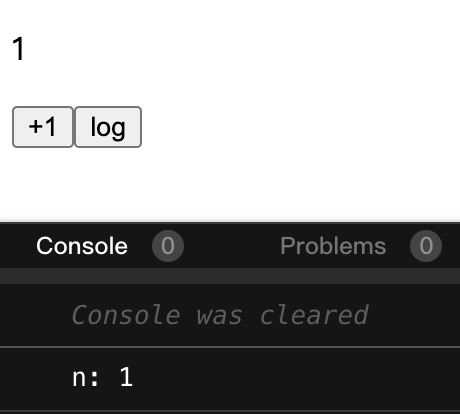
-
先log再+1时,控制台3s后打印出:
n : 0,而不是有部分人预想的n:1。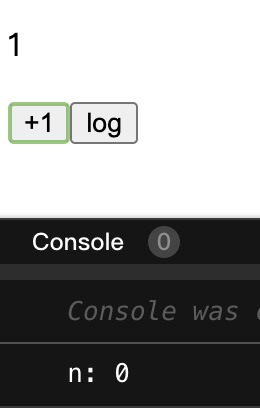
-
为什么log出了旧数据?
- 在单击log后,无论点击多少次+1,即无论n改变了几次,log始终都会读取点击log那一刻的n值
- 说明每次setN不会直接修改n值,而是产生一个新的n。
- 如果想要有一个贯穿始终的状态,办法有很多
3 贯穿始终的状态
最直接的方式就是定义全局变量,即window.xxx,除了很low别的没啥毛病
3.1 useRef
-
useRef不仅可以用于引用div,还能用于任意数据
-
示例
1 2 3 4 5 6 7 8 9 10 11 12 13 14 15 16 17 18 19import React from "react"; import ReactDOM from "react-dom"; const rootElement = document.getElementById("root"); function App() { const nRef = React.useRef(0); const log = () => setTimeout(() => console.log(`n: ${nRef.current}`), 1000); return ( <div className="App"> <p>{nRef.current} 这里并不能实时更新</p> <p> <button onClick={() => (nRef.current += 1)}>+1</button> <button onClick={log}>log</button> </p> </div> ); } ReactDOM.render(<App />, rootElement);无论+1与log的顺序如何,log总能打印出最新的n值,因为nRef是唯一的。
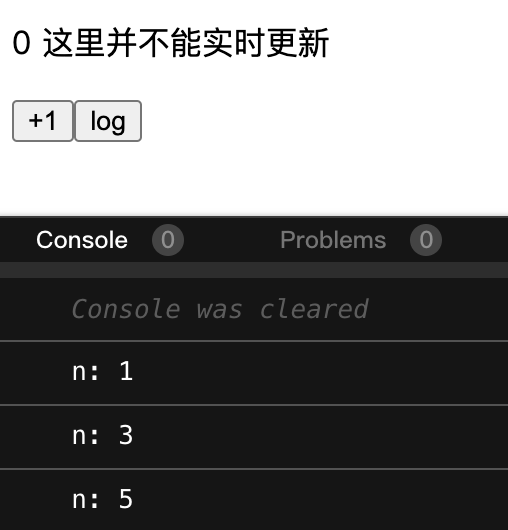
但nRef的改变并不能驱动页面刷新,可以借助useState帮助页面刷新
1 2 3 4 5 6 7 8 9 10 11 12 13 14 15 16 17 18 19 20 21... function App() { // useRef实际上就是个简单的对象 const nRef = React.useRef(0);// { current : 0 } // 只需借助setState方法 const update = React.useState(null)[1] const log = () => setTimeout(() => console.log(`n: ${nRef.current}`), 1000); return ( <div className="App"> <p>{nRef.current}</p> <p> <button onClick={() => { nRef.current += 1 update(nRef.current) }}>+1</button> <button onClick={log}>log</button> </p> </div> ); } ...在改变nRef的值时,随便改变一下setState的值,页面就会同时刷新
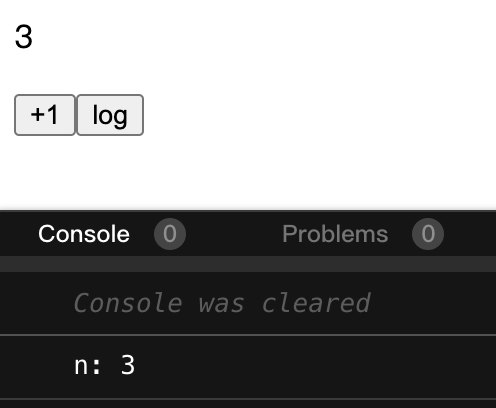
3.2 useContext
-
useContext不仅能贯穿始终,还能贯穿不同组件
-
示例
1 2 3 4 5 6 7 8 9 10 11 12 13 14 15 16 17 18 19 20 21 22 23 24 25 26 27 28 29 30 31 32 33 34 35 36 37 38 39 40 41 42 43 44 45 46import React from "react"; import ReactDOM from "react-dom"; import "./styles.css"; const rootElement = document.getElementById("root"); // 创建上下文(全局)对象 const themeContext = React.createContext(null); function App() { const [theme, setTheme] = React.useState("red"); return ( // 将状态值theme以及改变状态的方法setTheme传入value中 <themeContext.Provider value={{ theme, setTheme }}> // 通过theme值改变className,从而改变主题样式 <div className={`App ${theme}`}> <p>{theme}</p> <div> <ChildA /> </div> <div> <ChildB /> </div> </div> </themeContext.Provider> ); } function ChildA() { // 通过useContext读取到父组件的themeContext对象,取出其中的setTheme方法 const { setTheme } = React.useContext(themeContext); return ( <div> <button onClick={() => setTheme("red")}>red</button> </div> ); } function ChildB() { const { setTheme } = React.useContext(themeContext); return ( <div> <button onClick={() => setTheme("blue")}>blue</button> </div> ); } ReactDOM.render(<App />, rootElement);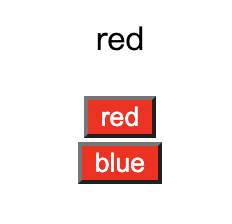
3.3 总结
- 每次重新渲染,组件函数就会再次执行
- 对应的所有state都会出现
「分身」,旧的state和新的state可以同时存在(例如setTimeout时),之后旧的state会消失(垃圾回收) - 如果你不希望出现分身,可以用
useRef/useContext等
Author gsemir
LastMod 2021-08-07